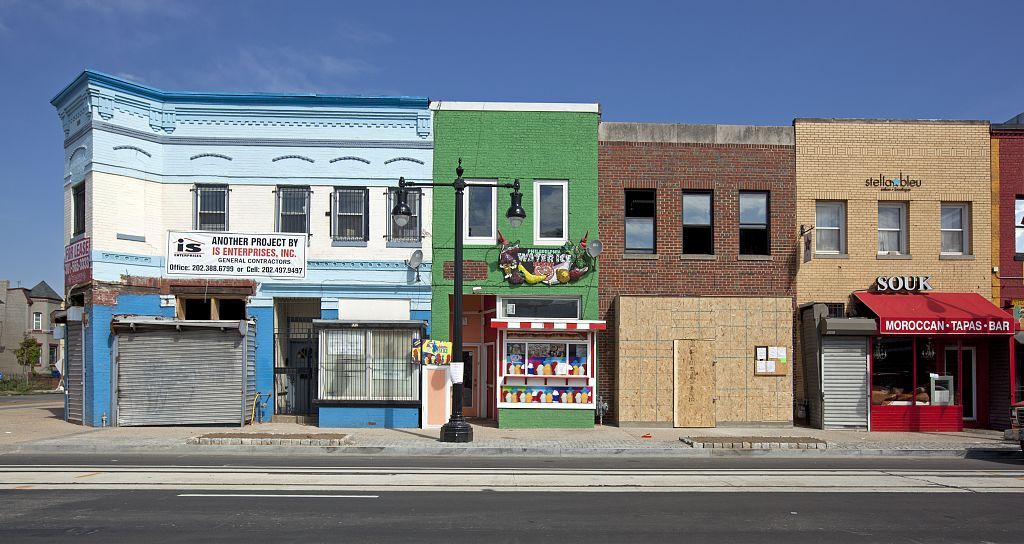Hello there! Welcome back to the blog! I’m Elijah Leer, and last time you heard from me, I was writing about the Smithsonian American Art Museum! Since then, a lot has happened, but today, I’m here to talk about our January 23rd visit to the Atlas Performing Arts Center. As it was a rather contentious visit, I have no doubt that some of my classmates will also be writing about the Atlas, but Professor Epstein says that this is okay. Thanks Professor Epstein!
:max_bytes(150000):strip_icc()/Atlas_CORE_01_michael-moran-56a237283df78cf772735a09.jpg)
The Atlas marquee, as it may have appeared during its movie theater heyday.
The history of the Atlas is particularly interesting, so I’d like to share some of it with you. Built in 1938, the Atlas Movie Theater was a staple of H Street for thirty years. Unfortunately, the 1968 riots that followed the death of Martin Luther King, Jr. left the area largely abandoned, and the theater closed permanently in the 1970s. In the 80s, the building was purchased by the H Street Community Development Corporation, and multi-million dollar renovations began in earnest. Hailed as a “community anchor” that would foster continued reinvestment in the neighborhood, the Performing Arts Center opened in 2005, and its operations have grown ever since.
At this point, I must acknowledge that the language used above is not my own. It has been provided by the Atlas and by its executive director, Douglas Yeuell, through our discussion with him. I am fully aware of the general undercurrent of gentrification that the words seem to mask, and I don’t think I’m alone in my discomfort with it. Over the course of the last month, the class has encountered several historically black neighborhoods that have disappeared in the wake of new, expensive, “desirable” housing, according to the large advertisements that frame such areas.

A section of a city block on H Street, present day. Shops selling Moroccan food and Philadelphia water ice are visible.
To its credit, the neighborhood that surrounds the Atlas seems only halfway through the disappearing process. Among the buildings on H Street, the Atlas’s renovations stand out as unusual, and plenty of the location’s small business staples are still operating today. Nevertheless, the circumstances and mission behind the Atlas’s founding seem rather complicit in “urban renewal” tendencies. At the same time, the Center provides about two million dollars of free and reduced programming each year to members of the immediate community, suggesting a genuine interest in preserving its historic inhabitants. In his comments, Yeuell seemed aware of the potential impact of his institution and emphasized the active roll he was taking to make these impacts as positive as possible. Of course, whether or not these attempts will be sufficient (or if they’ll have the best interests of the community in mind) remains to be seen.
Ultimately, I walked away from the encounter with a confused sense of unease that has persisted to this day. The confusion stems from the fact that, with its community outreach programs and clear desire to dialogue with those who attend its programming, the Atlas certainly outperforms other institutions we’ve visited. Its leadership seemed at least semi-engaged with community partners and appeared to desire their input in decision-making. And yet, were the Atlas to realize its plans for success, H Street would inevitably be transformed into an expensive, modern, and likely unrecognizable neighborhood. It would fall victim to the urban renewal (or urban removal) that has been the fate of countless other areas of DC, and it would represent yet another example of the cultural erasure that is so prevalent here. So I’m uneasy. I don’t know what will happen to H Street. I hope that the city has the sense to let it stick around a while longer.
Works Cited
https://www.atlasarts.org/support/
https://www.atlasarts.org/staff-board/
https://web.archive.org/web/20131207015115/http://realestatehappenz.com/neighborhoods/hst/hst.cfm
